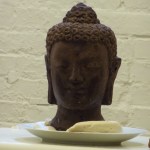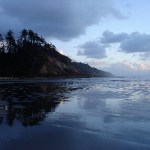metagenomics
I got to spend last week in sunny California. I forgot how wonderful it is to sit and eat lunch outside! I was participating in a workshop held at the Department of Energy's Joint Genome Institute (JGI). The workshop was entitled Microbial Genomics and Metagenomics. Basically I spent the week learning about different tools that are available to help biologists deal with the data flood that has come out (and continues to flow faster and faster) of sequencing technologies that continue to get faster and cheaper.
Since microbes are not exactly easy to observe with ones eyes,…
It's been exciting to see the progress in getting the Theobroma cacao genome sequenced and off to the databases.
But....
I've toured the Theo chocolate factory twice now, and there's a crucial piece in the story that appears to be missing.
photo by S. Porter 2010
You see, chocolate is like wine. We don't get the chocolate we love from eating the fruit. We get the so-called "food of the gods" by eating the fruit after it's been fermented. And, just like wine, microorganisms are the ones doing the fermenting.
I learned this from attending two separate tours at Theo chocolates, our local…
"Digital biology," as I use the phrase, refers to the idea of using digital information for doing biology. This digital information comes from multiple sources such as DNA sequences, protein sequences, DNA hybridization, molecular structures, analytical chemistry, biomarkers, images, GIS, and more. We obtain this information either from experiments or from a wide variety of databases and we work with this information using several kinds of bioinformatics tools.
The reason I'm calling this field "digital biology" and not "bioinformatics" (even though I typically use the terms as…
I just love this title! It's nerdy and cute, all at the same time.
I read about this in www.researchblogging.org and had to check out the paper and blog write up from The Beagle Project (BTW: some of you may be interested in knowing that The Beagle Project is not a blog about dogs.)
The paper describes a class where students from Marseilles University investigate the function of unidentified genes from a Global Ocean Sampling experiment. All the sequences are obtained from the environmental sequence division at the NCBI.
Students follow the procedure outlined below:
This is a great…
Hey students: if you are looking for a summer internship in marine metagenomics and you can get your application together before June 16th, Jonathan Eisen posted information about an open position on his blog.
It also looks like he's looking for post-docs (see the side bar on the right of this page.)
Have you ever wondered what kinds of viruses can be found in human waste?
Mya Breitbart and team have been sequencing nucleic acids from fecal samples in order to find out. You might expect that we'd find viruses that infect humans or viruses that infect the bacteria in our gut.
I wouldn't have expected to learn the result that they found.
A large number, 60% of the viral DNA sequences were from unknown viruses. That's not a surprise. The surprise came when they looked at the RNA viruses.
Instead, the viral sequences most often came from a plant pathogen called the pepper mild mottle…
I'm in Berkeley right now at the annual Bio-Link Summer Fellows forum. We're getting to hear talks from people in the biotech industry, listen to enthusiastic instructors describe their biotech programs and ideas, and try out new educational materials.
Yesterday, two speakers (Damon Tighe and Jason Baumohl) from the Joint Genome Institute in Walnut Creek, CA, gave a fun talk about DNA sequencing and sequence assembly.
They also showed some very nice Flash animations, made by Damon Tighe, at the JGI, that illustrate how DNA sequencing is done. There's no sound, but the animations are…
Ribosomes are molecular machines that build new proteins. This process of synthesizing a protein is also known as translation.
Many antibiotics prevent translation by binding to ribosomal RNA. In the class that I'm teaching, we're going to be looking at ribosome structures to see if the polymorphisms that we find in the sequences of 16S ribosomal RNA are related antibiotic resistance.
This is related to our metagenomics project where we investigate the polymorphisms we find in 16S ribosomal RNAs.
This 6 minute video introduces ribosomes, discusses where they're found, what they're made of,…
Okay OpenOffice fans, show me what you can do.
Earlier this week, I wrote about my challenges with a bug in Microsoft Excel that only appears on Windows computers. Since I use a Mac, I didn't know about the bug when I wrote the assignment and I only found out about it after all but one of my students turned in assignment results with nonsensical pie graphs.
So, I asked what other instructors do with software that behaves differently on different computing platforms. I never did hear from any other instructors, but I did hear from lots of Linux fans. And, lots of other people kindly…
Do different kinds of biomes (forest vs. creek) support different kinds of bacteria?
Or do we find the same amounts of each genus wherever we look?
Those are the questions that we'll answer in this last video. We're going to use pivot tables and count all the genera that live in each biome. Then, we'll make pie graphs so that we can have a visual picture of which bacteria live in each environment.
The parts of this series are:
I. Downloading the data from iFinch and preparing it for analysis. (this is the video below) (We split the data from one column into three).
II. Cleaning up the data…
This is third video in our series on analyzing the DNA sequences that came from bacteria on the JHU campus.
In this video, we use a pivot table to count all the different types of bacteria that students found in 2004 and we make a pie graph to visualize the different numbers of each genus.
The parts of this series are:
I. Downloading the data from iFinch and preparing it for analysis. (this is the video below) (We split the data from one column into three).
II. Cleaning up the data
III. Counting all the bacteria
IV. Counting the bacteria by biome
Part III. Pivot tables from Sandra Porter on…
What do you do after you've used DNA sequencing to identify the bacteria, viruses, or other organisms in the environment?
What's the next step?
This four part video series covers those next steps. In this part, we learn that a surprisingly large portion of bioinformatics, or any type of informatics is concerned with fixing data entry errors and spelling mistakes.
The parts of this series are:
I. Downloading the data from iFinch and preparing it for analysis. (this is the video below) (We split the data from one column into three).
II. Cleaning up the data
III. Counting all the bacteria…
For the past few years, I've been collaborating with a friend, Dr. Rebecca Pearlman, who teaches introductory biology at the Johns Hopkins University. Her students isolate bacteria from different environments on campus, use PCR to amplify the 16S ribosomal RNA genes, send the samples to the JHU core lab for sequencing, and use blastn to identify what they found.
Every year, I collect the data from her students' experiments. Then, in the bioinformatics classes I teach, we work with the chromatograms and other data to see what we can find.
This is the first part of a four part video series…
We have lots of DNA samples from bacteria that were isolated from dirt. Now it's time to our own metagenomics project and figure out what they are. Our class project is on a much smaller scale than the honeybee metagenomics project that I wrote about yesterday, but we're using many of the same principles.
The general process is this:
1. We sort the chromatogram data to identify good data and separate it from bad data. Informatics can help you determine if data is good, and measure how good it is, but it cannot turn bad data into good data. And, there's no point in wasting time with…
A few years ago, the General Biology students at the Johns Hopkins University began to interrogate the unseen world. During this semester-long project, they study the ecosystems of the Homewood campus, and engage in novel research by exploring the microbial ecosystems in different sections of the campus. Biology lab students gather environmental samples from different campus ecosystems, isolate DNA, amplify 16s ribosomal DNA by PCR, and check their PCR results by gel electrophoresis.
DNA samples are next sent to the university's Genetic Resources Core Facility , where scientific staff, in…

